Panel Products
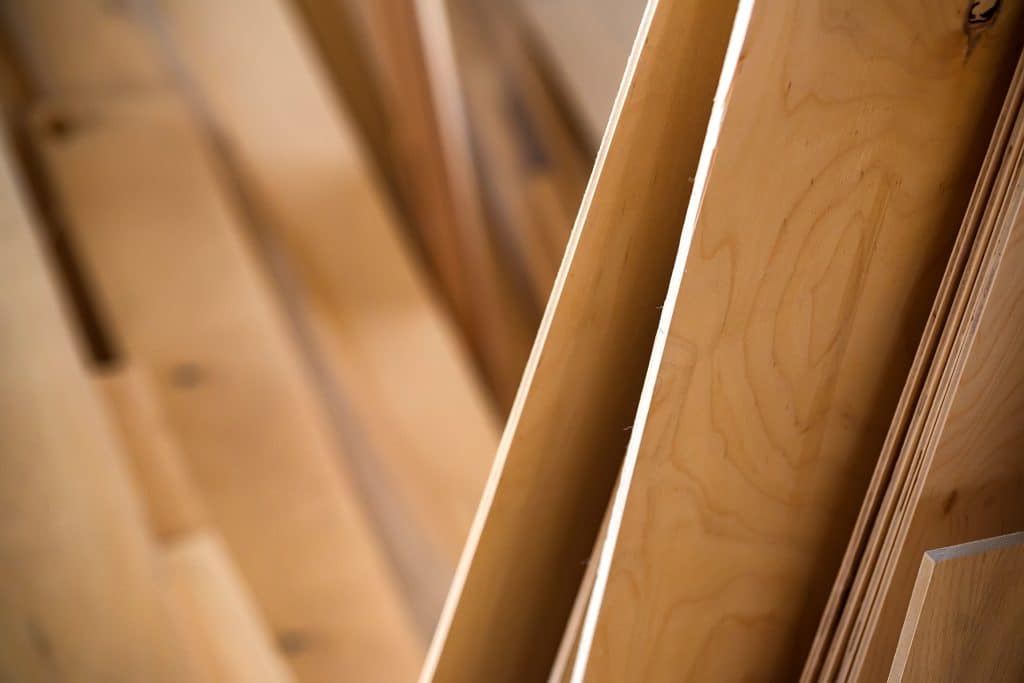
By using roundwood that is often not be suitable for lumber production, wood-based panels make efficient use of the forest resource by providing engineered wood products with defined strength and stiffness properties. Wood-based structural panels such as plywood and oriented strand board (OSB) are widely used in residential and commercial construction. Wood-based panels are often overlaid on joists or light frame trusses and used as structural sheathing for floor, roofs and wall assemblies. These products provide rigidity to the supporting main structural members in addition to their function as a component of the building envelope. In addition, they are often an integral component of the lateral force resisting system of a wood building. In order to qualify for a particular end use, such as structural sheathing, flooring or exterior siding, wood-based panels must meet performance criteria related to three aspects: structural performance, physical properties and bond performance. For more information on performance rating and potential end uses of wood-based panel products, refer to APA – The Engineered Wood Association.
Laminate Veneer Lumber
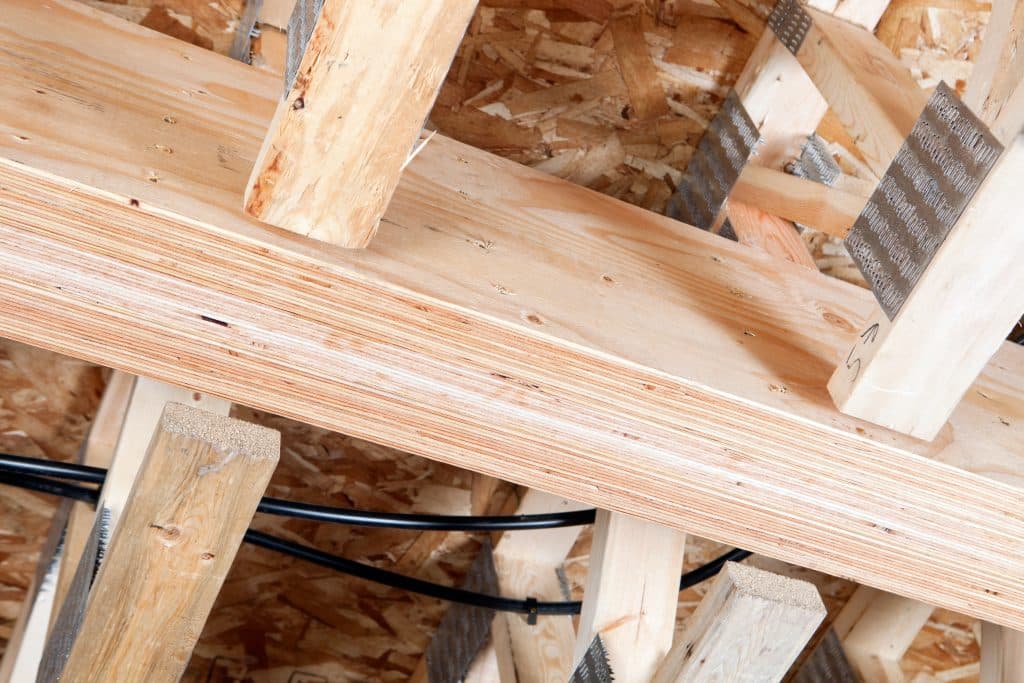
First used during World War II to make airplane propellers, laminated veneer lumber (LVL) has been available as a construction product since the mid-1970s. LVL is the most widely used structural composite lumber (SCL) product and provides attributes such as high strength, high stiffness and dimensional stability. The manufacturing process of LVL enables large members to be made from relatively small trees, providing efficient utilization of forest resources. LVL is commonly fabricated using wood species such as Douglas fir, Larch, Southern yellow pine and Poplar. LVL is used primarily as structural framing for residential and commercial construction. Common applications of LVL in construction include headers and beams, hip and valley rafters, scaffold planking, and the flange material for prefabricated wood I-joists. LVL can also been used in roadway sign posts and as truck bed decking. LVL is made of dried and graded wood veneer which is coated with a waterproof phenol-formaldehyde resin adhesive, assembled in an arranged pattern, and formed into billets by curing in a heated press. The LVL billet is then sawn to desired dimensions depending on the end use application. The grain of each layer of veneer runs in the same (long) direction with the result that LVL is able to be loaded on its short edge (strong axis) as a beam or on its wide face (weak axis) as a plank. This type of lamination is called parallel-lamination and produces a material with greater uniformity and predictability than engineered wood products fabricated using cross-lamination, such as plywood. LVL is a solid, highly predictable, uniform lumber product due to the fact that natural defects such as knots, slope of grain and splits have been dispersed throughout the material or have been removed altogether during the manufacturing process. The most common thickness of LVL is 45 mm (1-3/4 in), from which wider beams can be easily constructed by fastening multiple LVL plies together on site. LVL can also be manufactured in thicknesses from 19 mm (3/4 in) to 178 mm (7 in). Commonly used LVL beam depths are 241 mm (9-1/2 in), 302 mm (11-7/8 in), 356 mm (14 in), 406 mm (16 in), 476 mm (18-3/4 in) and 606 mm (23-7/8 in). Other widths and depths might also be available from specific manufacturers. LVL is available in lengths up to 24.4 m (80 ft), while more common lengths are 14.6 m (48 ft), 17 m (56 ft), 18.3 m (60 ft) and 20.1 m (66 ft). LVL can easily be cut to length at the jobsite. All special cutting, notching or drilling should be done in accordance with manufacturer’s recommendations. LVL is a wood-based product with similar fire performance to a comparably sized solid sawn lumber or glued-laminated beam. Manufacturer’s catalogues and evaluation reports are the primary sources of information for design, typical installation details and performance characteristics. LVL is mainly used as a structural element, most often in concealed spaces where appearance is not important. Finished or architectural grade appearance is available from some manufacturers, usually at an additional cost. However, when it is desired to use LVL in applications where appearance is important, common wood finishing techniques can be used to accent grain and to protect the wood surface. In finished appearance, LVL resembles plywood or lumber on the wide face. As with any other wood product, LVL should be protected from the weather during jobsite storage and after installation. Wrapping of the product for shipment to the job site is important in providing moisture protection. End and edge sealing of the product will enhance its resistance to moisture penetration. LVL is a proprietary product and therefore, the specific engineering properties and sizes are unique to each manufacturer. Thus, LVL does not have a common standard of production and common design values. Design values are derived from test results analysed in accordance with CSA O86 and ASTM D5456 and the design values are reviewed and approved by the Canadian Construction Materials Centre (CCMC). Products meeting the CCMC guidelines receive an Evaluation Number and Evaluation Report that includes the specified design strengths, which are subsequently listed in CCMC’s Registry of Product Evaluations. The manufacturer’s name or product identification and the stress grade is marked on the material at various intervals, but due to end cutting it may not be present on every piece. For further information, refer to the following resources: APA – The Engineered Wood Association Canadian Construction Materials Centre (CCMC), Institute for Research in Construction CSA O86 Engineering design in wood ASTM D5456 Standard Specification for Evaluation of Structural Composite Lumber Products
Laminated Strand Lumber
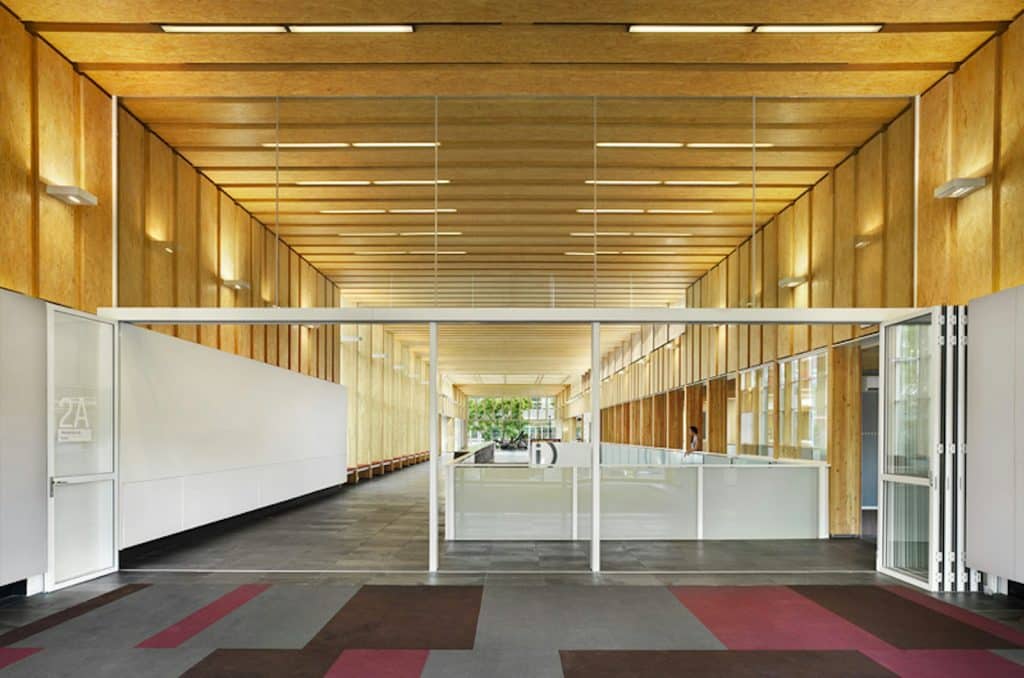
Laminated Strand Lumber (LSL) is one of the more recent structural composite lumber (SCL) products to come into widespread use. LSL provides attributes such as high strength, high stiffness and dimensional stability. The manufacturing process of LSL enables large members to be made from relatively small trees, providing efficient utilization of forest resources. LSL is commonly fabricated using fast growing wood species such as Aspen and Poplar. LSL is used primarily as structural framing for residential, commercial and industrial construction. Common applications of LSL in construction include headers and beams, tall wall studs, rim board, sill plates, millwork and window framing. LSL also offers good fastener-holding strength. Similar to parallel strand lumber (PSL) and oriented strand lumber (OSL), LSL is made from flaked wood strands that have a length-to-thickness ratio of approximately 150. Combined with an adhesive, the strands are oriented and formed into a large mat or billet and pressed. LSL resembles oriented strand board (OSB) in appearance as they are both fabricated from the similar wood species and contain flaked wood strands, however, unlike OSB, the strands in LSL are arranged parallel to the longitudinal axis of the member. LSL is a solid, highly predictable, uniform engineered wood product due to the fact that natural defects such as knots, slope of grain and splits have been dispersed throughout the material or have been removed altogether during the manufacturing process. Like other SCL products such as LVL and PSL, LSL offers predictable strength and stiffness properties and dimensional stability that minimize twist and shrinkage. All special cutting, notching or drilling should be done in accordance with manufacturer’s recommendations. Manufacturer’s catalogues and evaluation reports are the primary sources of information for design, typical installation details and performance characteristics. As with any other wood product, LSL should be protected from the weather during jobsite storage and after installation. Wrapping of the product for shipment to the job site is important in providing moisture protection. End and edge sealing of the product will enhance its resistance to moisture penetration. LSL is a proprietary product and therefore, the specific engineering properties and sizes are unique to each manufacturer. Thus, LSL does not have a common standard of production and common design values. Design values are derived from test results analysed in accordance with CSA O86 and ASTM D5456 and the design values are reviewed and approved by the Canadian Construction Materials Centre (CCMC). Products meeting the CCMC guidelines receive an Evaluation Number and Evaluation Report that includes the specified design strengths, which are subsequently listed in CCMC’s Registry of Product Evaluations. The manufacturer’s name or product identification and the stress grade is marked on the material at various intervals, but due to end cutting it may not be present on every piece. For further information, refer to the following resources: APA – The Engineered Wood Association Canadian Construction Materials Centre (CCMC), Institute for Research in Construction CSA O86 Engineering design in wood ASTM D5456 Standard Specification for Evaluation of Structural Composite Lumber Products
Oriented Strand Lumber
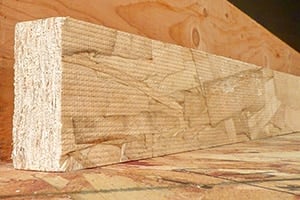
Oriented Strand Lumber (OSL) Oriented Strand Lumber (OSL) provides attributes such as high strength, high stiffness and dimensional stability. The manufacturing process of OSL enables large members to be made from relatively small trees, providing efficient utilization of forest resources. OSL is used primarily as structural framing for residential, commercial and industrial construction. Common applications of OSL in construction include headers and beams, tall wall studs, rim board, sill plates, millwork and window framing. OSL also offers good fastener-holding strength. Similar to laminated strand lumber (LSL), OSL is made from flaked wood strands that have a length-to-thickness ratio of approximately 75. The wood strands used in OSL are shorter than those in LSL. Combined with an adhesive, the strands are oriented and formed into a large mat or billet and pressed. OSL resembles oriented strand board (OSB) in appearance as they are both fabricated from the similar wood species and contain flaked wood strands, however, unlike OSB, the strands in OSL are arranged parallel to the longitudinal axis of the member. OSL is a solid, highly predictable, uniform engineered wood product due to the fact that natural defects such as knots, slope of grain and splits have been dispersed throughout the material or have been removed altogether during the manufacturing process. Like other SCL products such as LVL and PSL, OSL offers predictable strength and stiffness properties and dimensional stability that minimize twist and shrinkage. All special cutting, notching or drilling should be done in accordance with manufacturer’s recommendations. Manufacturer’s catalogues and evaluation reports are the primary sources of information for design, typical installation details and performance characteristics. As with any other wood product, OSL should be protected from the weather during jobsite storage and after installation. Wrapping of the product for shipment to the job site is important in providing moisture protection. End and edge sealing of the product will enhance its resistance to moisture penetration. OSL is a proprietary product and therefore, the specific engineering properties and sizes are unique to each manufacturer. Thus, OSL does not have a common standard of production and common design values. Design values are derived from test results analysed in accordance with CSA O86 and ASTM D5456 and the design values are reviewed and approved by the Canadian Construction Materials Centre (CCMC). Products meeting the CCMC guidelines receive an Evaluation Number and Evaluation Report that includes the specified design strengths, which are subsequently listed in CCMC’s Registry of Product Evaluations. The manufacturer’s name or product identification and the stress grade is marked on the material at various intervals, but due to end cutting it may not be present on every piece. For further information, refer to the following resources: APA – The Engineered Wood Association Canadian Construction Materials Centre (CCMC), Institute for Research in Construction CSA O86 Engineering design in wood ASTM D5456 Standard Specification for Evaluation of Structural Composite Lumber Products
Parallel Strand Lumber
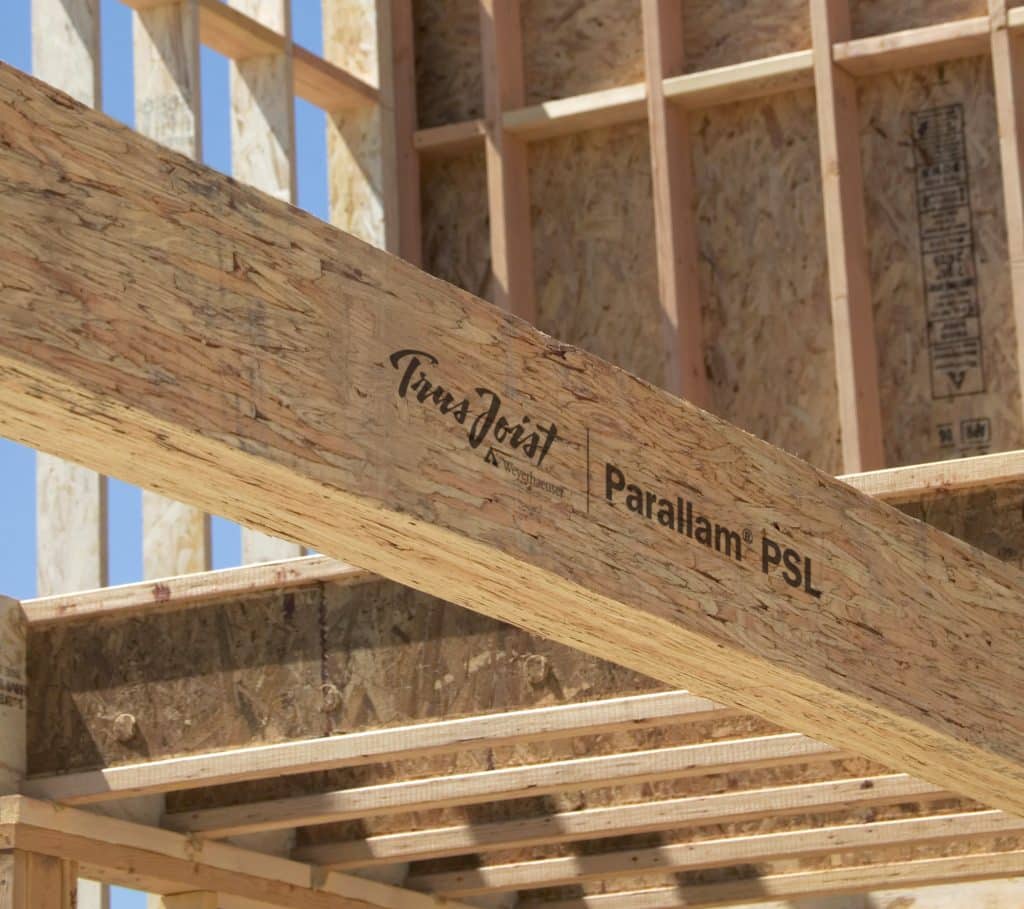
Parallel Strand Lumber (PSL) Parallel Strand Lumber (PSL) provides attributes such as high strength, high stiffness and dimensional stability. The manufacturing process of OSL enables large members to be made from relatively small trees, providing efficient utilization of forest resources. In Canada, PSL is fabricated using Douglas fir. PSL is employed primarily as structural framing for residential, commercial and industrial construction. Common applications of PSL in construction include headers, beams and lintels in light-frame construction and beams and columns in post and beam construction. PSL is an attractive structural material which is suited to applications where finished appearance is important. Similar to laminated strand lumber (LSL) and oriented strand lumber (OSL), PSL is made from flaked wood strands that are arranged parallel to the longitudinal axis of the member and have a length-to-thickness ratio of approximately 300. The wood strands used in PSL are longer than those used to manufacture LSL and OSL. Combined with an exterior waterproof phenol-formaldehyde adhesive, the strands are oriented and formed into a large billet, then pressed together and cured using microwave radiation. PSL beams are available in thicknesses of 68 mm (2-11/16 in), 89 mm (3-1/2 in), 133 mm (5-1/4 in), and 178 mm (7 in) and a maximum depth of 457 mm (18 in). PSL columns are available in square or rectangular dimensions of 89 mm (3-1/2 in), 133 mm (5-1/4 in), and 178 mm (7 in). The smaller thicknesses can be used individually as single plies or can be combined for multi-ply applications. PSL can be made in long lengths but it is usually limited to 20 m (66 ft) by transportation constraints. PSL is a solid, highly predictable, uniform engineered wood product due to the fact that natural defects such as knots, slope of grain and splits have been dispersed throughout the material or have been removed altogether during the manufacturing process. Like the other SCL products (LVL, LSL and OSL), PSL offers predictable strength and stiffness properties and dimensional stability. Manufactured at a moisture content of 11 percent, PSL is less prone to shrinking, warping , cupping, bowing and splitting. All special cutting, notching or drilling should be done in accordance with manufacturer’s recommendations. Manufacturer’s catalogues and evaluation reports are the primary sources of information for design, typical installation details and performance characteristics. PSL exhibits a rich texture and retains numerous dark glue lines. PSL can be machined, stained, and finished using the techniques applicable to sawn lumber. PSL members readily accept stain to enhance the warmth and texture of the wood. All PSL is sanded at the end of the production process to ensure precise dimensions and to provide a high quality surface for appearance. As with any other wood product, PSL should be protected from the weather during jobsite storage and after installation. Wrapping of the product for shipment to the job site is important in providing moisture protection. End and edge sealing of the product will enhance its resistance to moisture penetration. PSL readily accepts preservative treatment and it is possible to obtain a high degree of preservative penetration. Treated PSL can be specified in high humidity exposures. PSL is a proprietary product and therefore, the specific engineering properties and sizes are unique to each manufacturer. Thus, PSL does not have a common standard of production and common design values. Design values are derived from test results analysed in accordance with CSA O86 and ASTM D5456 and the design values are reviewed and approved by the Canadian Construction Materials Centre (CCMC). Products meeting the CCMC guidelines receive an Evaluation Number and Evaluation Report that includes the specified design strengths, which are subsequently listed in CCMC’s Registry of Product Evaluations. The manufacturer’s name or product identification and the stress grade is marked on the material at various intervals, but due to end cutting it may not be present on every piece. The Canadian Construction Materials Centre (CCMC) has accepted PSL for use as heavy timber construction, as described under the provisions within Part 3 of the National Building Code of Canada. For further information, refer to the following resources: APA – The Engineered Wood Association Canadian Construction Materials Centre (CCMC), Institute for Research in Construction CSA O86 Engineering design in wood ASTM D5456 Standard Specification for Evaluation of Structural Composite Lumber Products
Wood in non-combustible buildings
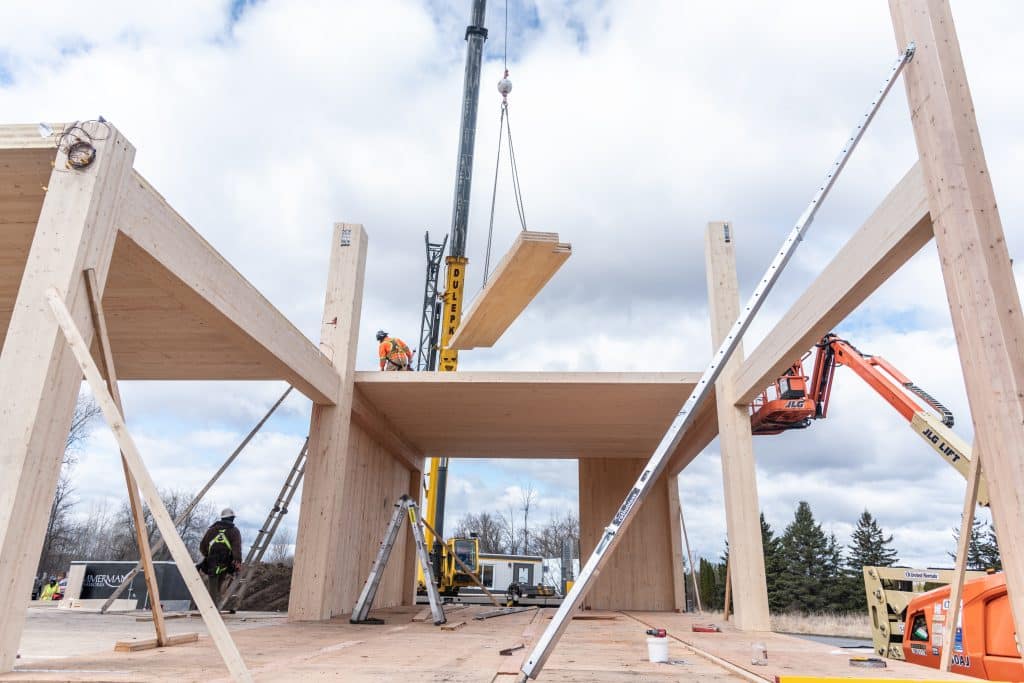
The National Building Code of Canada (NBC) requires that some buildings be of ‘noncombustible construction’ under its prescriptive requirements. Noncombustible construction is, however, something of a misnomer, in that it does not exclude the use of ‘combustible’ materials but rather, it limits their use. Some combustible materials can be used since it is neither economical nor practical to construct a building entirely out of ‘noncombustible’ materials. Wood is probably the most prevalent combustible material used in noncombustible buildings and has numerous applications in buildings classified as noncombustible construction under the NBC. This is due to the fact that building regulations do not rely solely on the use of noncombustible materials to achieve an acceptable degree of fire safety. Many combustible materials are allowed in concealed spaces and in areas where, in a fire, they are not likely to seriously affect other fire safety features of the building. For example, there are permissions for use of heavy timber construction for roofs and roof structural supports. It may also be used in partition walls and as wall finishes, as well as furring strips, fascia and canopies, cant strips, roof curbs, fire blocking, roof sheathing and coverings, millwork, cabinets, counters, window sashes, doors, and flooring. Its use in certain types of buildings such as tall buildings is slightly more limited in areas such as exits, corridors and lobbies, but even there, fire-retardant treatments can be used to meet NBC requirements. The NBC also allows the use of wood cladding for buildings designated to be of noncombustible construction. In sprinklered noncombustible buildings not more than two-storeys in height, entire roof assemblies and the roof supports can be heavy timber construction. To be acceptable, the heavy timber components must comply with minimum dimension and installation requirements. Heavy timber construction is afforded this recognition because of its performance record under actual fire exposure and its acceptance as a fire-safe method of construction. Fire loss experience has shown, even in unsprinklered buildings, that heavy timber construction is superior to noncombustible roof assemblies not having any fire-resistance rating. In other noncombustible buildings, heavy timber construction, including the floor assemblies, is permitted without the building being sprinklered. In sprinklered buildings permitted to be of combustible construction, no fire-resistance rating is required for the roof assembly or its supports when constructed from heavy timber. In these cases, a heavy timber roof assembly and its supports would not have to conform to the minimum member dimensions stipulated in the NBC. NBC definitions: Combustible means that a material fails to meet the acceptance criteria of CAN/ULC-S114, “Test for Determination of Non-Combustibility in Building Materials.” Combustible construction means that type of construction that does not meet the requirements for noncombustible construction. Heavy timber construction means that type of combustible construction in which a degree of fire safety is attained by placing limitations on the sizes of wood structural members and on thickness and composition of wood floors and roofs and by the avoidance of concealed spaces under floors and roofs. Noncombustible construction means that type of construction in which a degree of fire safety is attained by the use of noncombustible materials for structural members and other building assemblies. Noncombustible means that a material meets the acceptance criteria of CAN/ULC-S114, “Test for Determination of Non-Combustibility in Building Materials.” For further information, refer to the following resources: Wood Design Manual, Canadian Wood Council National Building Code of Canada CAN/ULC-S114 Test for Determination of Non-Combustibility in Building Materials Stairs and storage lockers in noncombustible buildings Stairs within a dwelling unit can be made of wood, as can storage lockers in residential buildings. These are permitted, as their use is not expected to present a significant fire hazard. Wood roofing materials in noncombustible buildings In the installation of roofing, wood cant strips, roof curbs, nailing strips, and similar components may be used. Wood roofs defined as ‘heavy timber construction’ in the NBC are permitted in any noncombustible building two-storeys or less in height when the building is protected by a sprinkler system. Roof sheathing and sheathing supports of wood are permitted in noncombustible buildings provided: The noncombustible parapets and shafts are required to prevent roof materials igniting from flames projecting from openings in the building face or roof deck.Roof coverings have often been contributing factors in conflagrations. Most roof coverings, even today, are combustible by the very nature of the materials used to make them waterproof. The objective of the NBC is to require that the risks associated with a roof covering be minimized for the type of building, its location and use. The NBC permits roof coverings that meet a Class C rating to be used for any building regulated by Part 3, including any noncombustible building, regardless of height or area. This C rating can be met easily using fire-retardant-treated wood (FRTW) shakes or shingles, asphalt shingles, or roll roofing. In buildings that are required to be of noncombustible construction, the roof coverings must have a fire classification of Class A, B or C. In such cases, the use of FRTW shakes and shingles on sloped roofs is allowed. Small assembly occupancy buildings not more than two-storeys in building height and less than 1000 m2 (10,000 ft2) in building area do not require a classification for the roof covering. In these traditional cases, untreated wood shingles are acceptable if they are underlaid with a noncombustible material to reduce the potential for burn through. Wood partitions in noncombustible buildings Wood framing has many applications in partitions in both low-rise and high-rise buildings required to be of noncombustible construction. The framing can be located in most types of partitions, with or without a fire- resistance rating. Wood framing and sheathing is permitted in partitions, or alternatively, solid lumber partitions at least 38 mm (2 in nominal) thick are permitted, provided: Alternatively, wood framing is permitted in partitions throughout floor areas, and can be used in most fire separations with no limits on compartment size or a need for sprinkler protection provided: Similarly, as a final
Cross-Laminated Timber (CLT)
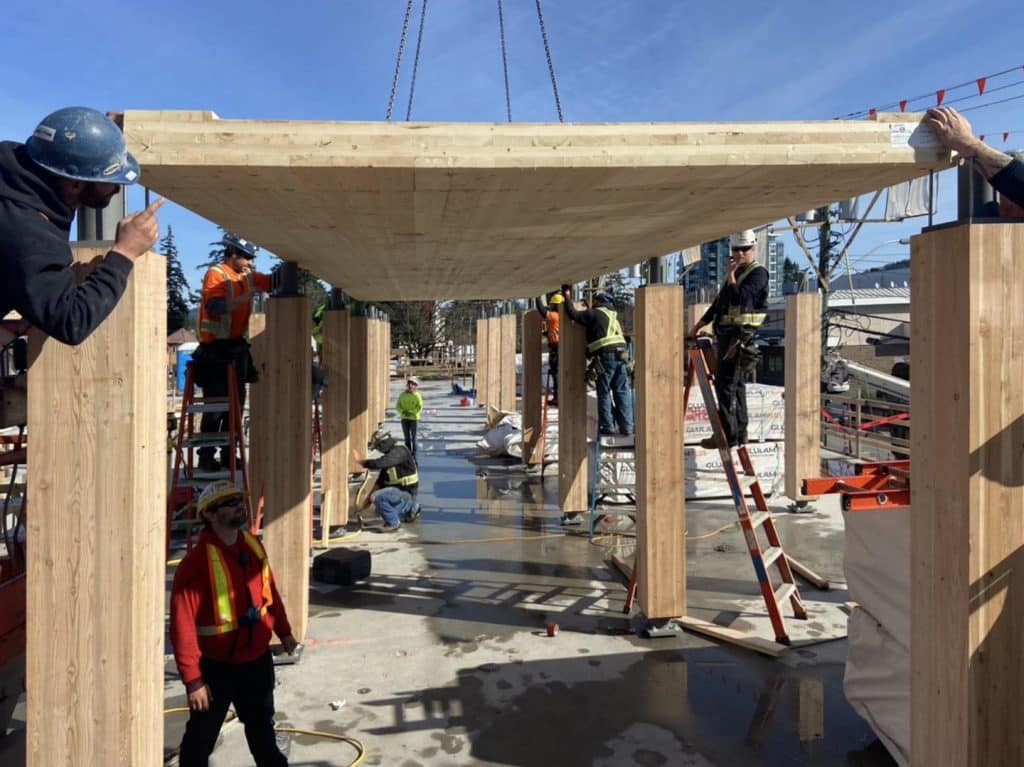
Cross-laminated timber (CLT) is a proprietary engineered wood product that is prefabricated using several layers of kiln-dried lumber, laid flat-wise, and glued together on their wide faces. Panels typically consist of three, five, seven or nine alternating layers of dimension lumber. The alternating directions of the CLT laminations provide it with high dimensional stability. CLT also has a high strength to weight ratio, along with exhibiting advantages for structural, fire, thermal and acoustic performance. Panel thicknesses usually range between 100 to 300 mm (4 to 12 in), but panels as thick as 500 mm (20 in) can be produced. Panel sizes range from 1.2 to 3 m (4 to 10 ft) in width and 5 to 19.5 m (16 to 64 ft) in length. The maximum panel size is limited by the size of the manufacturer’s press and transportation regulations. The design provisions for CLT in Canada apply to sawn lumber panels manufactured in accordance with the ANSI/APA PRG 320 standard. Typically, all the laminations in one direction are manufactured using the same grade and species of lumber. However, adjacent layers are permitted to be of different thickness and made of alternative grades or species. The moisture content of the lumber laminations at the time of CLT manufacturing is between 9 and 15%. There are five primary CLT stress grades; E1, E2, E3, V1 and V2. Stress grade E1 is the most readily available stress grade. The “E” designation indicates machine stress rated (MSR, or E-rated) lumber and the “V” designation indicates visually graded lumber. Stress grades E1, E2 and E3 consist of MSR lumber in all longitudinal layers and visually graded lumber in the transverse layers, while stress grades V1 and V2 consist of visually graded lumber in both longitudinal and transverse layers. Properties for custom CLT stress grades are also published by individual manufacturers. Similar to other proprietary structural wood products, CLT can be evaluated by the Canadian Construction Materials Centre (CCMC) in order to produce a product evaluation report. Unlike primary and custom CLT stress grades which are associated with structural capacity, appearance grades refer to the surface finish of CLT panels. Any stress grade can usually be produced in any surface finish targeted by the designer. Accommodations for reductions in strength and stiffness due to panel profiling or other face- or edge-finishes must be made. The Appendix of ANSI/APA PRG 320 provides examples of CLT appearance classifications. Structural adhesives used in bonding laminations must comply with CSA O112.10 and ASTM D7247 and are also evaluated for heat performance during exposure to fire. The different classes of structural adhesives that are typically used include: Emulsion polymer isocyanate (EPI); One-component polyurethane (PUR); Phenolic types such as phenol-resorcinol formaldehyde (PRF). Since pressure treatment with water-borne preservatives can negatively affect bond adhesion, CLT is not permitted to be treated with water-borne preservatives after gluing. For CLT treated with fire-retardant or other potentially strength-reducing chemicals, strength and stiffness is required to be based on documented test results. As part of the prefabrication process, CLT panels are cut to size, including door and window openings, with state-of-the art computer numerical controlled (CNC) routers, capable of making complex cuts with low tolerances. Prefabricated CLT elements arrive on site ready for immediate installation. CLT offers design flexibility and low environmental impacts for floor, roof and wall elements within innovative mid-rise and tall wood buildings. For further information on CLT, refer to the following resources: Kalesnikoff Nordic Structures APA – The Engineered Wood Association Canadian Construction Materials Centre (CCMC) Element5 ANSI/APA PRG 320 Standard for Performance-Rated Cross-Laminated Timber CSA O86 Engineering design in wood CSA O112.10 Evaluation of Adhesives for Structural Wood Products (Limited Moisture Exposure) ASTM D7247 Standard Test Method for Evaluating the Shear Strength of Adhesive Bonds in Laminated Wood Products at Elevated Temperatures
Tall Wood Buildings
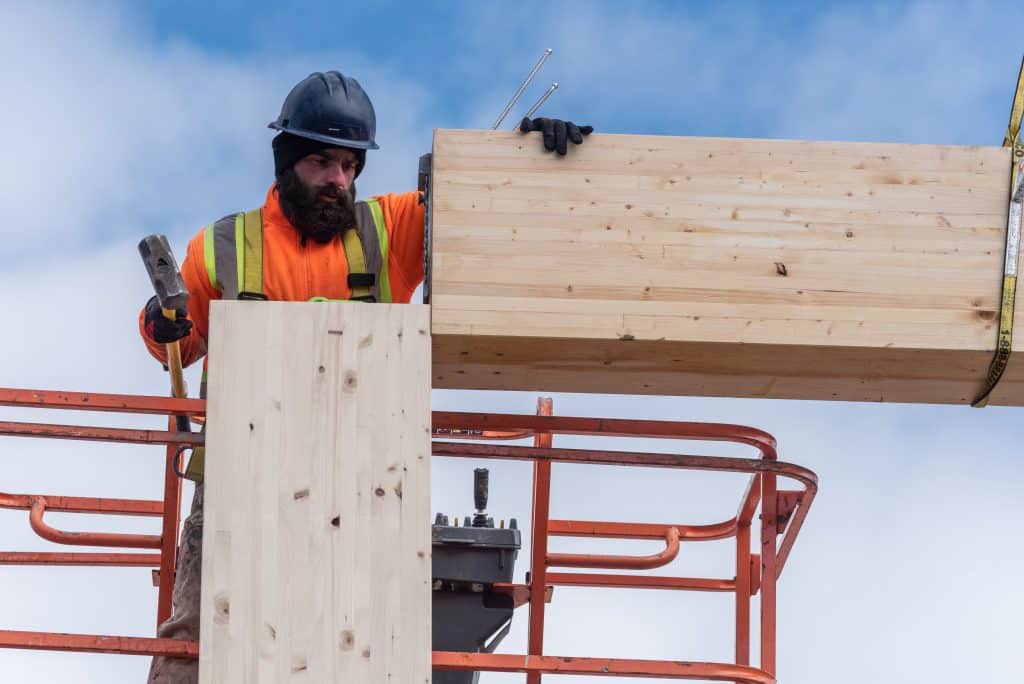
With advanced construction technologies and modern mass timber products such as glued-laminated timber, cross-laminated timber and structural composite lumber, building tall with wood is not only achievable but already underway – with completed contemporary buildings in Australia, Austria, Switzerland, Germany, Norway and the United Kingdom at 9 storeys and taller. Increasingly recognized by the construction sector as an important, new, and safe construction choice, the reduced carbon footprint and embodied / operational energy performance of these buildings is appealing to communities that are committed to sustainable development and climate change mitigation. Tall wood buildings, built with renewable wood products from sustainably managed forests, have the potential to revolutionize a construction industry increasingly focused on being part of the solution when it comes to urban intensification and environmental impact reduction. The Canadian wood product industry is committed to building on its natural advantage, through the development and demonstration of continuously improving wood-based building products and building systems. A tall wood building is a building over six-storeys in height (top floor is higher than 18 m above grade) that utilizes mass timber elements as a functional component of its structural support system. With advanced construction technologies and modern mass timber products such as glued-laminated timber (glulam), cross-laminated timber (CLT) and structural composite lumber (SCL), building tall with wood is not only achievable but already underway – with completed contemporary buildings in Canada, US, Australia, Austria, Switzerland, Germany, Norway, Sweden, Italy and the United Kingdom at seven-storeys and taller. Tall wood buildings incorporate modern fire suppression and protection systems, along with new technologies for acoustic and thermal performance. Tall wood buildings are commonly employed for residential, commercial and institutional occupancies. Mass timber offers advantages such as improved dimensional stability and better fire performance during construction and occupancy. These new products are also prefabricated and offer tremendous opportunities to improve the speed of erection and quality of construction. Some significant advantages of tall wood buildings include: the ability to build higher in areas of poor soils, as the super structure and foundations are lighter compared to other building materials; quieter to build on site, which means neighbours are less likely to complain and workers are not exposed to high levels of noise; worker safety during construction can be improved with the ability to work off large mass timber floor plates; prefabricated components manufactured to tight tolerances can reduce the duration of construction; tight tolerances in the building structure and building envelope coupled with energy modelling can produce buildings with high operational energy performance, increased air tightness, better indoor air quality and improved human comfort Design criteria for tall wood buildings that should be considered include: an integrated design, approvals and construction strategy, differential shrinkage between dissimilar materials, acoustic performance, behaviour under wind and seismic loads, fire performance (e.g., encapsulating the mass timber elements using gypsum), durability, and construction sequencing to reduce the exposure of wood to the elements. It is important to ensure early involvement by a mass timber supplier that can provide design assistance services that can further reduce manufacturing costs through the optimization of the entire building system and not just individual elements. Even small contributions, in connection designs for example, can make a difference to the speed of erection and overall cost. In addition, mechanical and electrical trades should be invited in a design-assist role at the outset of the project. This allows for a more complete virtual model, additional prefabrication opportunities and quicker installation. Recent case studies of modern tall wood buildings in Canada and around the world showcase the fact that wood is a viable solution for attaining a safe, cost-effective and high-performance tall building. For more information, refer to the following case studies and references: Brock Commons Tall Wood House (Canadian Wood Council) Origine Point-aux-Lievres Ecocondos,Quebec City (Cecobois) Wood Innovation and Design Centre (Canadian Wood Council) Technical Guide for the Design and Construction of Tall Wood Buildings in Canada (FPInnovations) Ontario’s Tall Wood Building Reference (Ministry of Natural Resources and Forestry & Ministry of Municipal Affairs) Summary Report: Survey of International Tall Wood Buildings (Forestry Innovation Investment & Binational Softwood Lumber Council) www.thinkwood.com/building-better/taller-buildings
Mid-Rise Buildings
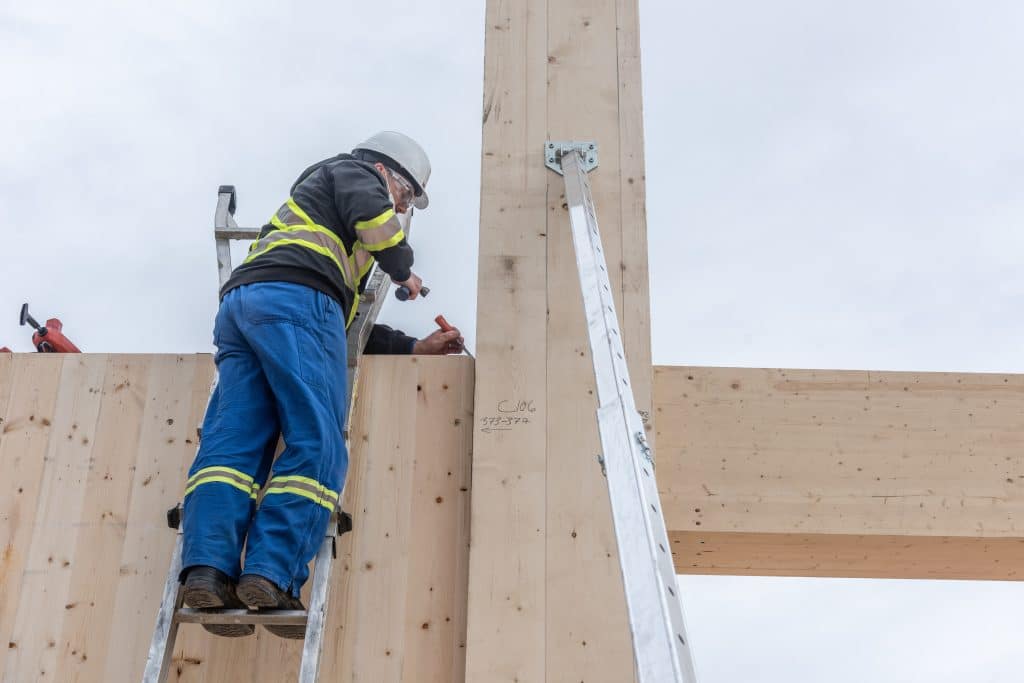
When it comes to wood construction, many people think of basic 2×4 framing, panels or flooring for single-family homes. However, advances in wood science and building technology have resulted in stronger, more sophisticated and robust products that are expanding the options for wood construction, and providing more choices for builders and architects. The Canadian Wood Council’s support for mid-rise construction is not unique In Ontario, Home Builders, through organizations such as RESCON, BILD and the Ontario Home Builders Association are also highlighting this opportunity. Mid-rise buildings made of wood are a new construction option for builders. That’s good news for main-street Canada, where land is so expensive. The net benefit of reduced construction costs is increased affordability for home buyers. In terms of new economic opportunity, the ability to move forward “now” creates new construction jobs in cities and supports employment in forestry communities. This also offers increased export opportunities for current and innovative wood products, where adoption in Canada provides the example for other countries. This also reflects a new standard of engineering in that structural, fire and seismic concerns have all been addressed by the expert committees of the Canadian Commission on Building and Fire Codes. In the end, when occupied, mid-rise buildings fully meet the same requirements of the Building Code as any other type of construction from the perspective of health, safety and accessibility.
Bridges
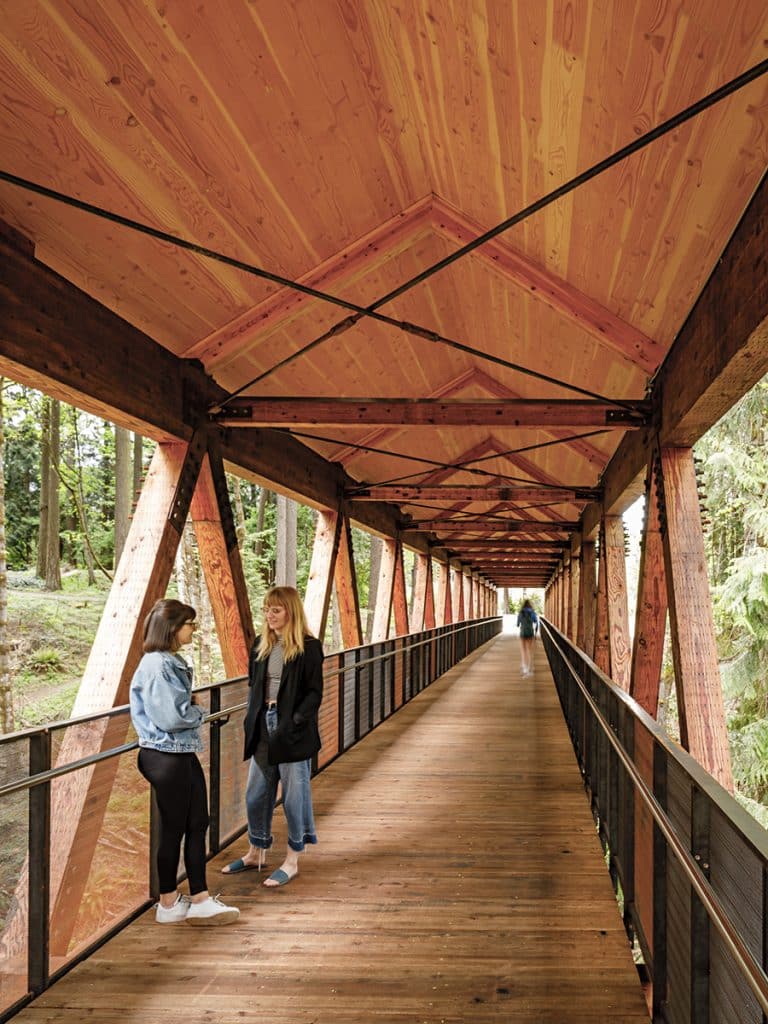
Timber bridges have a long history as vital components of the roadway, railway and logging road networks within Canada. Dependent on the availability of materials, technology, and labour, the design and construction of wood bridges has evolved significantly over the last 200 hundred years throughout North America. Wood bridges take on many forms and use alternative support systems; including simple span log bridges, different types of trussed bridges, and stress-laminated or composite bridge decks and components. Timber bridges remain an important part of our transportation network in Canada. The benefits of building modern timber bridges include: The different types of materials used to construct wood bridges include: sawn lumber, round logs, straight and curved glued-laminated timber (glulam), laminated veneer lumber (LVL), parallel strand lumber (PSL), cross-laminated timber (CLT), nail-laminated timber (NLT), and composite systems such as stress-laminated decks, wood-concrete laminated decks, and fibre-reinforced polymers. Two main wood species used for wood bridge construction in Canada are Douglas fir and the Spruce-Pine-Fir species combination. Other species within the Hem-Fir and Northern species combinations are also recognized under CSA O86, however, they are less commonly used in bridge construction. All metal fasteners used for bridges must be protected against corrosion. The most common method for providing protection is hot dip galvanizing, a process whereby a sacrificial metal is added to exterior of the fastener. Different fastener types that are used in wood bridge construction include, but are not limited to, bolts, lag screws, split rings, shear plates, and nails (for deck laminations only). All highway bridges in Canada must be designed to meet the requirements outlined in CSA S6 and CSA O86. The CSA S6 standard requires that the main structural components of any bridge in Canada, regardless of construction type, be able to withstand a minimum of 75 years of loading during its service life. The style and span of bridges varies greatly depending on the application. In hard to reach locations with deep valleys, timber trestle bridges were common at the end of the 19th century and into the beginning of the 20th century. Historically, trestle bridges relied heavily on ample timber resources and in some cases, were considered to be temporary. Initial construction of North America’s transcontinental railways would not have been possible without the use of timbers to construct bridges and trestles. Many examples of trussed timber bridges for have been built for well over a century. Trussed bridges allow for longer spans compared to simple girder bridges and historically had spans in the range of 30 to 60 m (100 to 200 ft). Bridges that are designed with trusses located above the deck provide a great opportunity to build a roof over the roadway. Installing a roof overhead is an excellent way to shed water away from the main bridge structure and protect it from the sun. The presence of these covered roofs is the main reason these century-old covered bridges remain in service today. The fact that they remain part of our landscape is as much a testament to their hardiness as to their attractiveness. Although originally devised as a rehabilitation measure for aging bridge decks, the stress-laminating technique has been extended to new bridges through the application of stressing at the time of original construction. Stress-laminated decks provide improved structural behaviour, through their excellent resistance to the effects of repeated loading. Three main considerations related to durability of wood bridges include protection by design, preservative treatment of wood, and replaceable elements. A bridge can be designed such that it is inherently self-protecting by deflecting water away from the structural elements. Preservative treated wood has the ability to resist the effects of de-icing chemicals and attack by biotic agents. Lastly, the bridge should be designed such that, at some point in its future, a single element can be replaced relatively easily, without significant disruption or cost. For further information, refer to the following resources: Wood Highway Bridges (Canadian Wood Council)Ontario Wood Bridge Reference Guide (Canadian Wood Council)CSA S6 Canadian Highway Bridge Design CodeCSA O86 Engineering design in wood
Tall Wood Buildings – Research
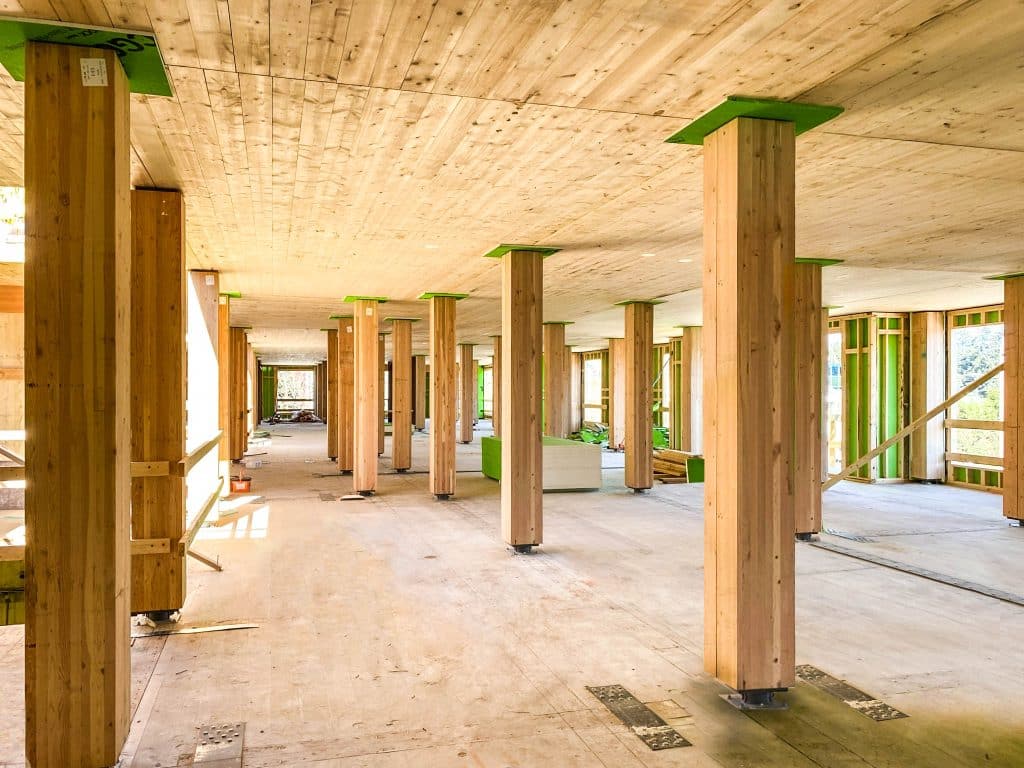
Tests Current research includes the World’s largest mass timber fire test – click here for updates on the test results currently being conducted https://firetests.cwc.ca/ Studies “The Historical Development of the Building Size Limits in the National Building Code of Canada (17 Mb) “Case Studies of Risk-to-Life due to Fire in Mid- and High-Rise, Combustible and Non-combustible Buildings Using CUrisk“, by Xia Zhang and George Hadjisophocleous of Carleton University, and Jim Mehaffey of CHM Fire Consultants Ltd. (March 2015) (2.3 Mb) “Fire Safety Challenges of Tall Wood Buildings”, by Robert Gerard and David Barber – Arup North America Ltd; Armin Wolski, San Francisco, CA; for the National Fire Protection Association’s Fire Protection Research Foundation (December 2013) “The Case for Tall Wood Buildings – How Mass Timber Offers a Safe, Economical, and Environmentally Friendly Alternative for Tall Building Structures“, by mgb ARCHITECTURE + DESIGN, Equilibrium Consulting, LMDG Ltd, and BTY Group (February 2012) (8.5 Mb) Ontario Tall Wood Reference Guide (8.04 MB) Reports Fire Research Final Report – Full-scale Mass Timber Shaft Demonstration Fire (including the National Research Council test report as an Appendix), by FPInnovations (April 2015) Acoustics Research and Guides RR-331: Guide to calculating airborne sound transmission in buildings (2nd Edition), by the National Research Council (April 2016) Tall Wood Building Demonstration Initiative Test Reports (funding provided by Natural Resources Canada) CLT Diaphragm Properties CLT Firestopping Testing Monotonic Quasi-Static Testing of CLT Connections Shear Modulus of CLT in plan loading Shear Testing of Cross-Laminated Beams Full Scale Exterior Wall Test on Nordic CLT System, by the National Research Council (January 2015) Client Report A1-005991.1 – Fire Endurance of Cross-Laminated Timber Floor and Wall Assemblies for Tall Wood Buildings, by the National Research Council (December 2014) Measurement of Airborne Sound Insulation of Wall & Floor Assemblies Visit Think Wood’s Research Library for additional resources
Mid-Rise Buildings – Research
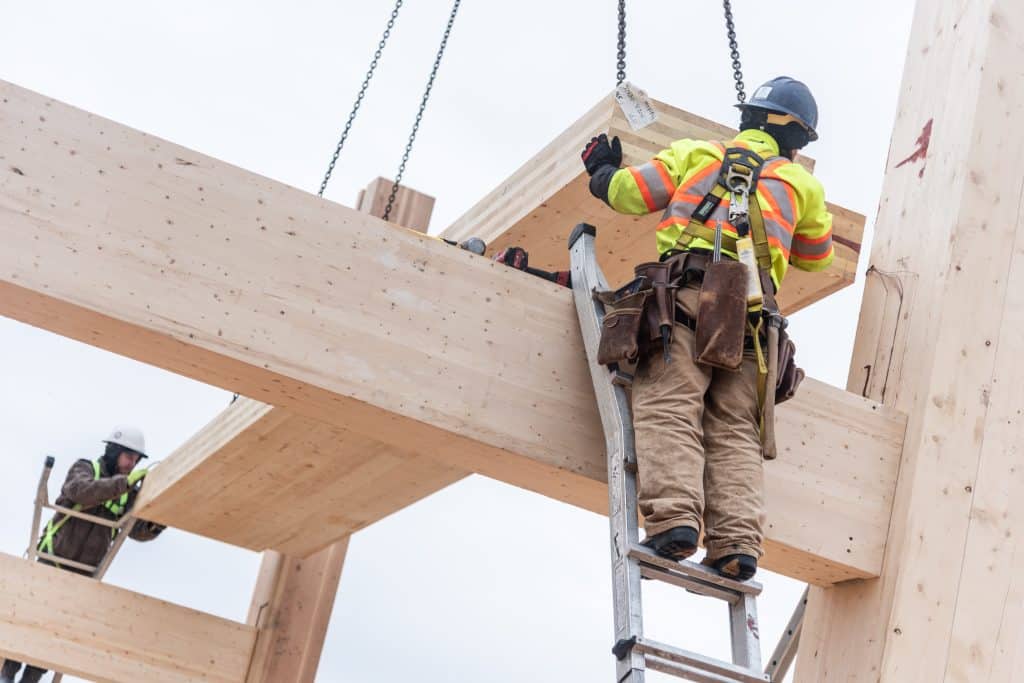
Studies General “The Historical Development of the Building Size Limits in the National Building Code of Canada“, by Sereca for CWC (2015) (17 Mb) Structural & Seismic Vertical Movement in Wood Platform Frame Structures (CWC Fact Sheets) Basics Design and detailing solutions Movement prediction Design of multi-storey wood-based shearwalls: Linear dynamic analysis & mechanics based approach A Mechanics-based Approach for Determining Deflections of Stacked Multi-storey Wood-based Shearwalls Design of Stacked Multi-storey Wood Shearwalls using a Mechanics Based Approach Linear Dynamic Analysis for Wood Based Shear Walls and Podium Structures Design of wood frame and podium structures using linear dynamic analysis, by Newfield, G., Ni, C., and Wang, J., Proceedings of the World Conference on Timber Engineering 2014, Quebec City, Canada (2014) Testing Other Reports Final Report – Full-scale Mass Timber Shaft Demonstration Fire (including the National Research Council test report as an Appendix), by FPInnovations (April 2015) Full Scale Exterior Wall Test on Nordic CLT System, by the National Research Council (January 2015) Report No. 101700231SAT-003_Rev.1 – Report of Testing Cross-Laminated Timber Panels for Compliance with CAN/ULC-S101 Standard Methods of Fire Endurance Tests of Building Construction and Materials: Loadbearing 3-ply CLT Wall with 1 Layer of 5/8″ Type X Gypsum Board – 1 hr FRR, by Intertek for CWC (November 2014) Report No. 100585447SAT-002B – Report of Testing Cross-Laminated Timber Panels for Compliance with CAN/ULC-S101 Standard Methods of Fire Endurance Tests of Building Construction and Materials: Loadbearing 3-ply CLT Wall with 1 Layer of 5/8″ Fire-rated Gypsum Board (60% load) – 1 hr FRR, by Intertek for CWC (December 2013) Report No. 100585447SAT-002A_Rev.1 – Report of Testing Cross-Laminated Timber Panels for Compliance with CAN/ULC-S101 Standard Methods of Fire Endurance Tests of Building Construction and Materials: Loadbearing 3-ply CLT Wall with Attached Wood-frame Partition – 1 hr FRR, by Intertek for CWC (January 2012) Visit Think Wood’s Research Library for additional resources

